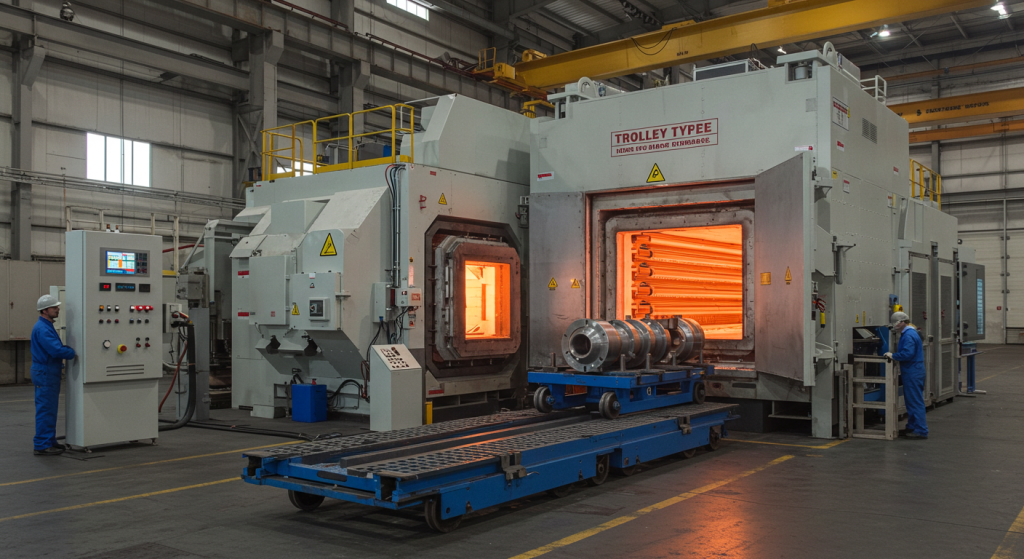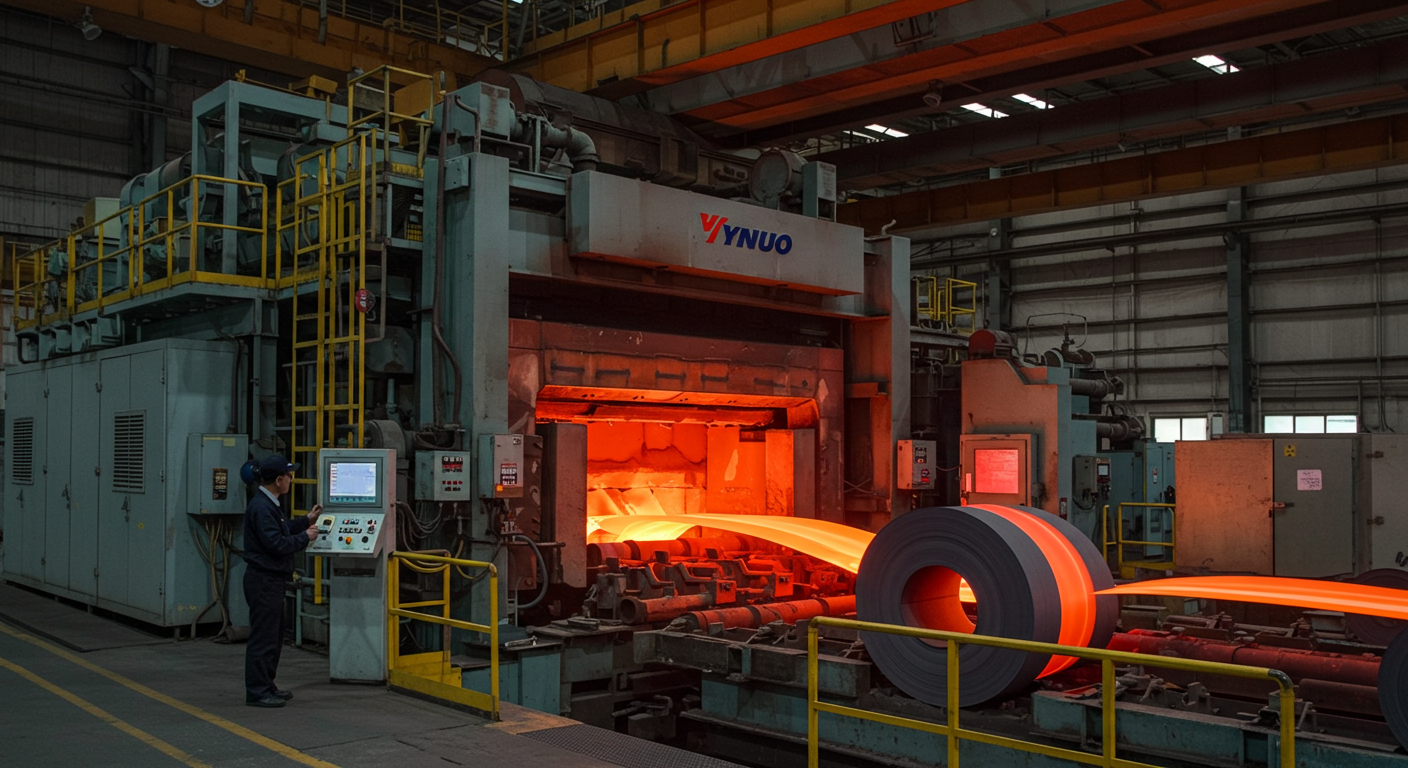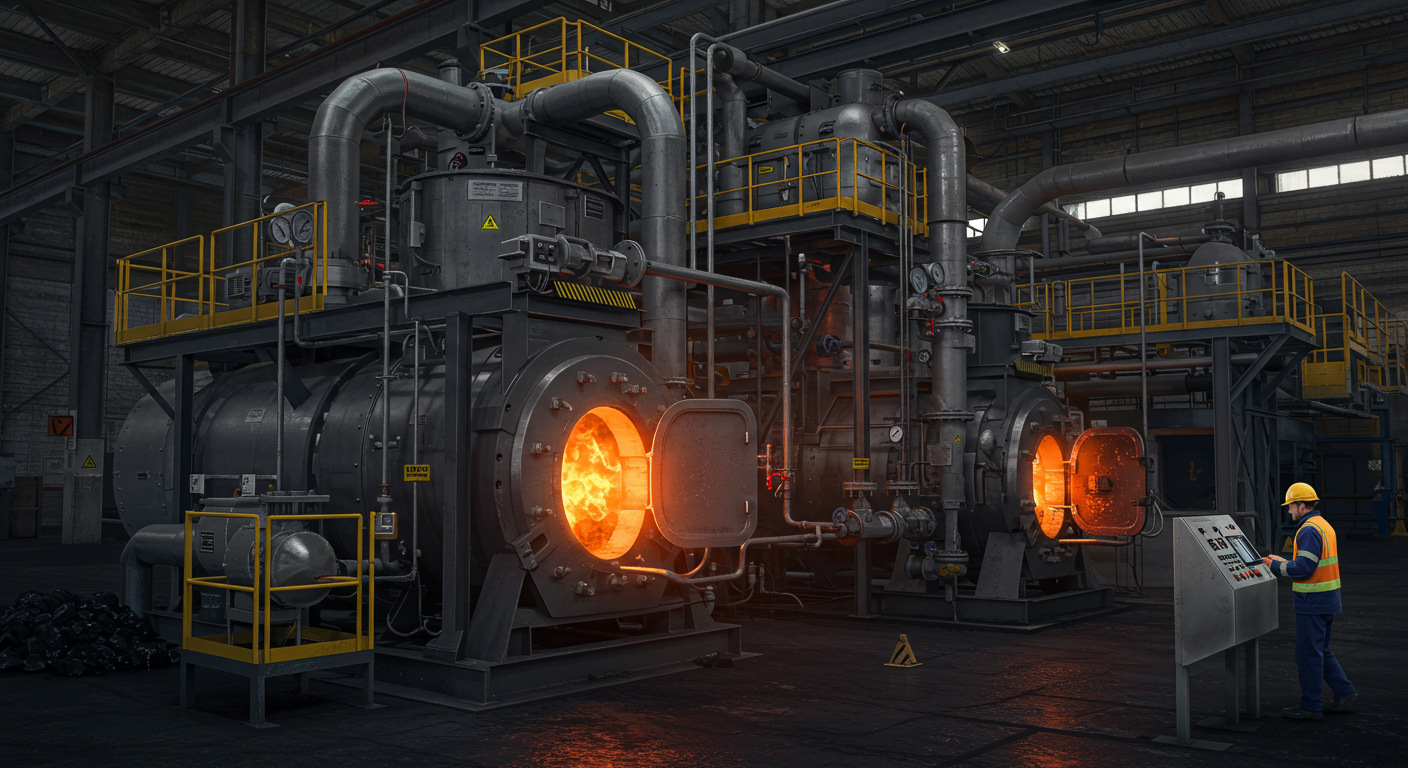
Trolley type resistance furnaces represent a versatile and efficient solution for industrial heat treatment, designed to process large and medium-sized metal castings, alloys, and mechanical parts through processes such as annealing, quenching, tempering, and normalizing. These furnaces utilize electric resistance heating to achieve precise temperature control, making them ideal for industries like steel manufacturing, automotive, and heavy machinery. Jiangsu Yinuo Thermal Energy Technology Co., Ltd., based in Xuzhou, China, stands as a global leader in manufacturing advanced trolley type resistance furnace solutions.
This guide explores the technology, applications, and benefits of these furnaces, detailing their role in modern industrial processing with a focus on precision, durability, and energy efficiency.
Understanding Trolley Type Resistance Furnace Technology
Trolley type resistance furnaces operate as periodic or batch systems, heating materials to temperatures typically between 650°C and 1400°C, depending on the heat treatment process. The design features a movable trolley that facilitates easy loading and unloading of heavy workpieces, enhancing operational efficiency. Electric resistance heating, combined with advanced insulation and control systems, ensures uniform temperature distribution and minimal energy loss, making these furnaces suitable for a wide range of industrial applications.
Core Components
A trolley type resistance furnace consists of a robust steel shell forming the furnace body, reinforced with welded steel frames for structural integrity. The heating chamber is lined with refractory materials, such as high-alumina bricks or ceramic fiber blankets, to withstand extreme temperatures and reduce heat loss. Electric resistance heating elements, typically high-temperature alloy wires or bands (e.g., 0Cr25Al5), are strategically placed on the furnace walls, door, and trolley for even heat distribution. A motorized trolley, equipped with heat-resistant cast steel or refractory platforms, supports heavy workpieces, moving on integrated rails for seamless loading and unloading. The furnace door, often with a lifting mechanism, ensures a tight seal to maintain thermal efficiency. Temperature control systems, incorporating microcomputer-based PID controllers or PLCs, regulate heating cycles, while atmosphere management systems, using inert gases like nitrogen, prevent oxidation during processing.
Operational Mechanism
Workpieces are loaded onto the trolley outside the furnace, typically on specialized refractory supports to prevent damage to heating elements. The trolley is then moved into the heating chamber via a motorized or hydraulic drive system, and the furnace door is sealed to initiate the heating cycle. Resistance heating elements generate heat, raising the chamber temperature to the desired setpoint, which is maintained during the soaking phase to ensure uniform heat penetration. Controlled cooling, either within the furnace or through external systems, completes the heat treatment process. The trolley is withdrawn for unloading, allowing rapid cycle times. Automation ensures precise temperature profiles, atmosphere control, and safety interlocks, such as alarms for overtemperature or flameout, enhancing reliability and repeatability.
Key Applications of Trolley Type Resistance Furnaces
Trolley type resistance furnaces serve a diverse range of industries, enabling precise heat treatment for metal components requiring specific mechanical properties. Their ability to handle heavy, large-scale workpieces makes them ideal for both general and specialized manufacturing environments.
Steel and Alloy Heat Treatment
In steel manufacturing, trolley type resistance furnaces are employed for annealing, quenching, tempering, and normalizing of high-chromium and high-manganese steel castings, as well as gray and ductile iron parts. Annealing softens steel for machining, while quenching enhances hardness for wear-resistant components like rollers and steel balls. These furnaces support large castings and alloy parts, ensuring uniform properties critical for structural integrity in construction and heavy machinery.
Automotive Component Processing
Automotive applications involve heat treating components such as gears, crankshafts, and suspension parts to improve durability and performance. Tempering in these furnaces reduces brittleness in hardened steel, while aging treatments enhance the strength of aluminum alloy components. The trolley system’s large loading capacity accommodates multiple parts per cycle, supporting high-volume production for automotive manufacturers.
Heavy Machinery and Tooling
Heavy machinery industries utilize these furnaces for heat treatment of large mechanical parts, such as pressure vessels, slewing bearings, and large shafts. Normalizing refines grain structure, improving toughness for components under extreme stress, while stress relieving prevents cracking in welded structures. The furnaces’ robust design handles heavy loads, ensuring reliability for critical tooling applications.
Ceramics and Specialized Materials
Beyond metals, trolley type resistance furnaces are used for sintering and firing ceramics, such as tableware or industrial components, requiring high-temperature processing. The furnaces’ precise temperature control and uniform heating ensure consistent ceramic quality, supporting industries like pottery and advanced materials manufacturing.
Benefits of Trolley Type Resistance Furnaces
Trolley type resistance furnaces offer distinct advantages, addressing the needs of industries prioritizing material quality, operational efficiency, and environmental responsibility. Their advanced design delivers performance tailored to demanding heat treatment applications.
High Loading Capacity
The trolley-based design supports large, heavy workpieces, with capacities ranging from several tons to over 50 tons, depending on furnace size. This enables processing of oversized castings or multiple components in a single cycle, reducing downtime and increasing productivity compared to smaller furnaces.
Energy Efficiency
Full-fiber linings, often made from high-purity ceramic fiber blankets, provide superior insulation, reducing heat loss by up to 60% compared to traditional brick linings, as noted in industry sources. Regenerative burners, where applicable, recover waste heat, further lowering fuel consumption. Electric resistance heating offers high thermal efficiency, minimizing energy costs and emissions.
Precision and Versatility
Microcomputer-based temperature controllers achieve accuracy within ±1–3°C, ensuring precise thermal cycles for annealing or tempering. Flexible configurations support a wide range of processes, from low-temperature aging (below 650°C) to high-temperature quenching (up to 1400°C), accommodating diverse materials and applications.
Operational Safety and Ease
Automated door and trolley mechanisms, combined with safety interlocks, prevent accidents during loading and unloading. Sealing systems, such as double-layer designs, minimize heat leakage and cold air infiltration, maintaining stable furnace conditions. User-friendly controls simplify operation, reducing the need for extensive operator training.
Technical Advantages of Trolley Type Resistance Furnaces
Trolley type resistance furnaces incorporate advanced features that optimize performance, durability, and sustainability, addressing the challenges of industrial heat treatment.
Superior Insulation
The use of high-purity ceramic fiber blankets, compressed into modular panels, enhances thermal resistance and insulation, as highlighted in industry practices. These fibers, anchored to the furnace’s steel shell, maintain structural integrity at high temperatures, reducing energy loss and extending furnace lifespan compared to traditional refractory bricks.
Advanced Heating Elements
High-resistance alloy wires or bands, such as 0Cr25Al5, are arranged on multiple furnace surfaces for even heat distribution. These elements resist corrosion and thermal fatigue, ensuring consistent performance over extended periods. Strategic placement minimizes damage from falling oxide scales, a common issue addressed through regular cleaning protocols.
Robust Sealing and Mobility
Double-layer sealing mechanisms between the trolley and furnace body, combined with gas-tight door designs, prevent heat loss and maintain atmosphere integrity, crucial for oxidation-sensitive processes. Motorized trolley systems with integrated rails enable smooth movement of heavy loads, enhancing operational efficiency and safety.
Automation and Safety Features
PLC-based control systems with microcomputer interfaces support programmable heating profiles, allowing multi-stage cycles for complex heat treatments. Safety features, including overtemperature alarms, flameout detection, and interlocking door-trolley controls, protect equipment and personnel, ensuring reliable operation in high-pressure environments.
Industry-Specific Considerations
Different industries require tailored trolley type resistance furnace configurations to meet specific process and material demands, ensuring optimal performance and cost efficiency.
Steel and Heavy Manufacturing
Steel applications prioritize high-capacity furnaces for large castings and rollers, requiring temperatures up to 1200°C for quenching or normalizing. Gas-fired or electric furnaces with regenerative burners reduce costs, while robust trolley designs handle loads exceeding 20 tons, supporting heavy manufacturing needs.
Automotive and Precision Components
Automotive applications demand precise temperature control for tempering or aging small to medium components. Electric furnaces with nitrogen atmospheres ensure clean surfaces for gears and shafts, while compact trolley designs optimize space in high-volume production lines.
Ceramics and Non-Metallic Materials
Ceramic processing requires furnaces with uniform temperatures for sintering, often below 1000°C. Conveyor or roller hearth-equipped trolleys facilitate continuous operation, while precise controls maintain stable conditions for delicate materials like tableware or industrial ceramics.
Aerospace and Specialty Alloys
Aerospace applications involve annealing high-performance alloys, requiring hydrogen or vacuum atmospheres to prevent oxidation. High-temperature furnaces (up to 1400°C) with rapid cooling capabilities support precision processing for components like turbine bearings, meeting strict industry standards.
Challenges and Solutions
Trolley type resistance furnaces face challenges like energy consumption, material quality control, and maintenance demands, but advanced engineering addresses these issues effectively.
Energy Consumption
High-temperature heat treatment consumes significant energy. Full-fiber insulation and regenerative burners reduce losses by up to 60%, while electric heating offers high efficiency for smaller furnaces, as noted in industry sources. Energy audits optimize operating parameters, further lowering costs.
Material Quality Control
Non-uniform heating or scaling can cause defects. Multi-zone temperature control and protective atmospheres ensure uniform heating, while automated monitoring prevents atmosphere leaks, critical for high-quality alloy processing.
Maintenance and Wear
Heavy loads and high temperatures stress trolley components and heating elements. Robust alloy elements and ceramic-lined trolleys reduce wear, while regular maintenance, such as purging oxide scale from furnace floors, prevents short circuits, as recommended by industry practices. IoT-enabled diagnostics minimize downtime.
Future Trends in Trolley Type Resistance Furnaces
The trolley type resistance furnace industry is evolving, driven by advancements in automation, sustainability, and material processing, shaping the future of industrial heat treatment.
Automation and Smart Technology
AI-driven controls and IoT integration enable real-time optimization, predictive maintenance, and process tracking. Automated systems reduce labor costs and enhance precision, supporting high-volume production with complex thermal cycles, meeting modern manufacturing demands.
Sustainability Initiatives
Electric furnaces with renewable energy integration lower carbon emissions, aligning with environmental regulations. Ultra-low NOx burners and advanced insulation reduce environmental impact, supporting sustainable manufacturing practices and global compliance.
Advanced Material Processing
Demand for furnaces supporting high-performance alloys and ceramics is rising. Furnaces are adapting to process materials like nickel-based superalloys or advanced ceramics, requiring precise thermal cycles, supporting innovation in aerospace and electronics.
Choosing a Trolley Type Resistance Furnace
Selecting a trolley type resistance furnace requires evaluating process, material, and production needs to ensure optimal performance and cost efficiency.
Key Considerations
Material type, such as steel or ceramics, determines furnace configuration and atmosphere requirements. Process needs—annealing, quenching, or tempering—dictate temperature range and heating system. Production scale influences furnace size, with high-capacity trolleys suiting large castings. Energy efficiency, driven by insulation and burner design, impacts costs. Automation and maintenance support ensure reliability.
Partnering with Jiangsu Yinuo
Jiangsu Yinuo’s team provides expert guidance, designing custom furnaces tailored to industrial goals. Installation and ongoing support ensure seamless performance, delivering precision and efficiency. Clients can explore solutions and connect through the Jiangsu Yinuo website for tailored furnace options, backed by global expertise.
FAQ
What is the purpose of a trolley type resistance furnace?
Trolley type resistance furnaces heat treat metal castings and parts for annealing, quenching, or tempering, enhancing mechanical properties for industrial applications.
What materials can trolley type resistance furnaces process?
Steel, high-chromium alloys, manganese alloys, cast iron, and ceramics are processed, supporting steel, automotive, and ceramic industries.
How is furnace quality ensured?
Production involves rigorous testing of components, using premium refractories, with compliance documentation meeting ISO and CE standards.
Are trolley type resistance furnaces customizable?
Furnaces are tailored to specific material, process, and production needs, with support from design to installation.
How energy-efficient are trolley type resistance furnaces?
Full-fiber insulation and regenerative burners reduce energy use by up to 60%, lowering costs and emissions.
How can a quote be requested from Jiangsu Yinuo?
A contact form, email, or phone inquiry through the Jiangsu Yinuo website provides a prompt response.
Conclusion
Trolley type resistance furnaces deliver precision, efficiency, and sustainability, driving high-quality heat treatment in steel, automotive, and ceramic industries. Jiangsu Yinuo Thermal Energy Technology Co., Ltd. offers innovative, customized solutions that empower manufacturers globally. With advanced technology and a focus on performance, these furnaces meet the demands of modern industrial processing. Explore solutions and connect through the website for a tailored quote to enhance production capabilities today.







